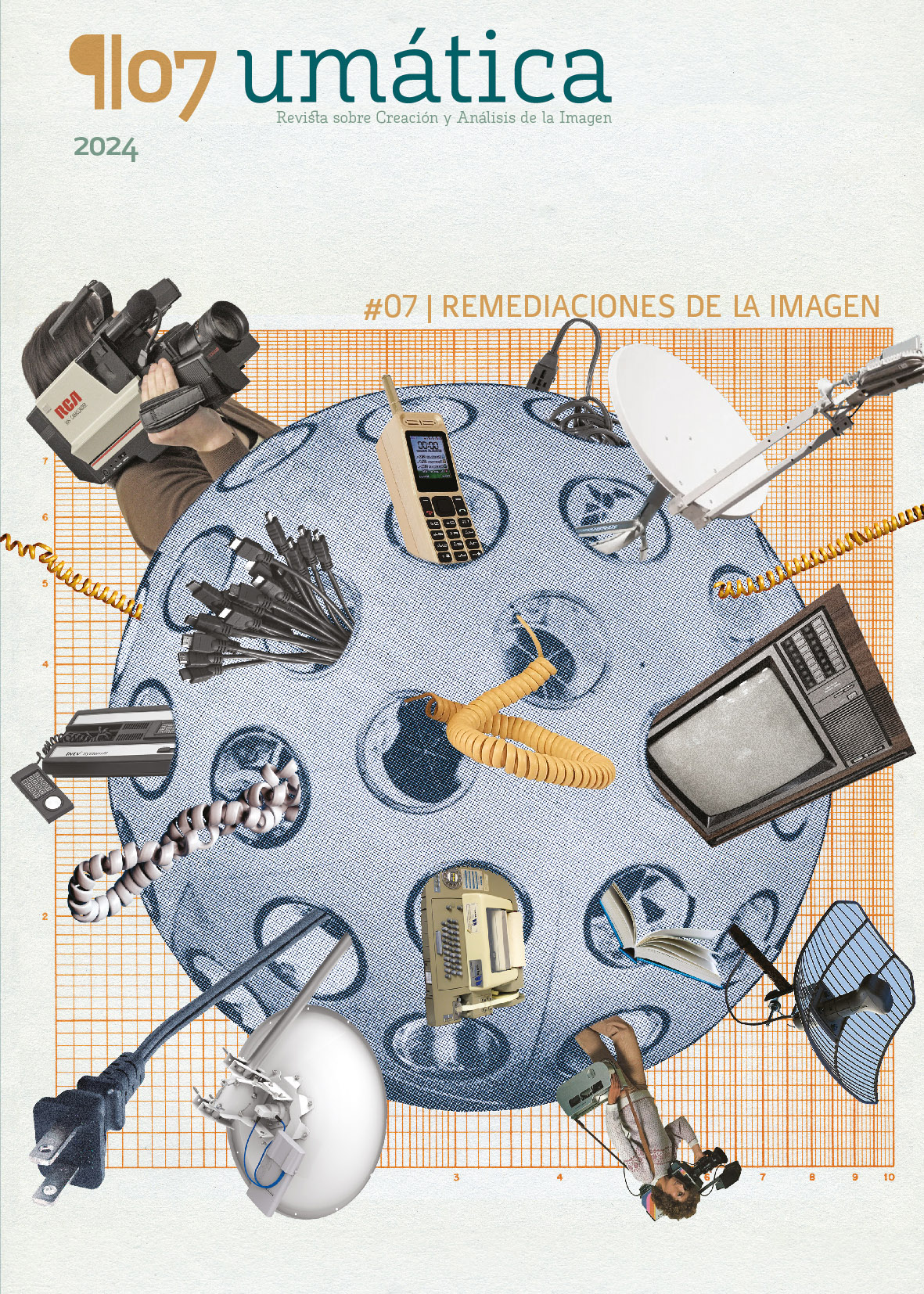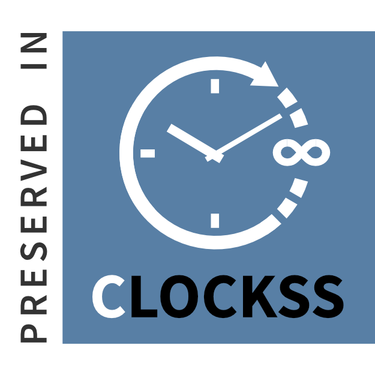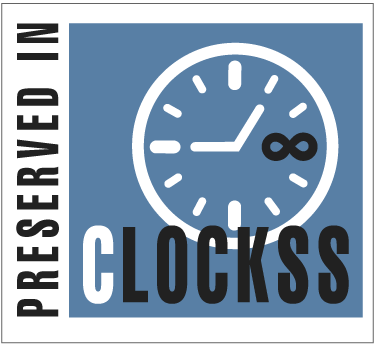El asalto televisivo a la historia del arte. Modos de ver en la disputa por la propiedad intelectual de las imágenes del arte
DOI:
https://doi.org/10.24310/umatica.2024.v6i7.20382Palabras clave:
John Berger, Hans Magnus Enzensberger, Oskar Negt, Alexander Kluge, Propiedad intelectualResumen
Este artículo parte de la escasa recepción crítica en castellano de la serie documental y el libro Ways of Seeing (WoS, 1972) y se aparta de las interpretaciones preponderantes anglosajonas para argumentar que su relevancia no se debería tanto a su temática como a haber retado la propiedad de las obras de arte y la autoridad académica mediante el asalto audiovisual al canon artístico. A diferencia de otras propuestas, WoS no habría recurrido a la televisión para afianzar el relato académico del arte, sino que habría encontrado en la mediación audiovisual la posibilidad de desligar sus imágenes de la autoridad de los expertos y la propiedad de las élites para favorecer experiencias heterodoxas. Esto se sustentará a) reconstruyendo el argumento que se ofrece en WoS respecto a cómo la audiovisualización cuestionaría la propiedad y autoridad de las imágenes del arte; b) relacionando su invitación a asaltar el canon artístico con los debates posteriores a 1968 en el trabajo de Hans Magnus Enzensberger, Oskar Negt y Alexander Kluge; y, c) inscribiendo WoS en un intento más amplio de conformación de una contraesfera pública que disputaría el orden legal y material de la “propiedad intelectual” que regulaba las mediaciones audiovisuales en el periodo.
Descargas
Métricas
Publicación Facts
Perfil de revisores N/D
Información adicional autores
Indexado: {$indexList}
-
Indexado en
- Sociedad Académica/Grupo
- N/D
- Editora:
- Universidad de Málaga (España)
Citas
Adorno, T. W. (1954). How to Look at Television. The Quarterly of Film, Radio and Television. 8(3), 213-235. https://doi.org/10.2307/1209731
Althusser, L. (1970). Idéologie et appareils idéologiques d’État (Notes pour une recherche). La Pensée, (151).
Art-Language. (1978). Ways of Seeing. Art-Language, 4(3).
Bal, M. (2012). S-word. Journal of Visual Culture, 11(2), 145-148.
Baudrillard, J. (1972). Pour une critique de l’économie politique du signe. Gallimard.
Berger, J. (1957). The New Nihilists. Labour Monthly, 123-126. https://www.unz.com/print/LabourMonthly-1957mar-00123/
Berger, J. (2008). Hold Everything Dear: Dispatches on Survival and Resistance. Verso.
Berger J., Bloomberg, S., Fox, C., Dibb, M. y Hollis, R. (1974). Modos de ver (J. G. Beramendi, Trad.). Gustavo Gili.
Boyle, D. (1997). Subject to Change. Guerrilla Television Revisited. Oxford University Press.
Bruck, J. y Docker, J. (1989). Puritanic rationalism: John Berger’s Ways of Seeing and media and culture studies. Continuum, 2(2), 77-95. https://doi.org/10.1080/10304318909359365
Brunsdon, C. y Morley, D. (1978). Everyday Television: ‘Nationwide’. British Film Institute.
Conlin, J. (2016). ‘An irresponsible flow of images’: Berger, Clark, and the Art of Television, 1958-1988. En R. Hertel y D. Malcolm (Eds.), On John Berger: Telling Stories (pp. 269-291). Brill Publishers.
Conlin, J. (2020). Lost in Transmission? John Berger and the Origins of Ways of Seeing (1972). History Workshop Journal, (90), 142-163. https://doi.org/10.1093/hwj/dbaa020
Debord, G. (1967). La société du spectacle. Buchet-Chastel.
Downing, J. (2001). Radical Media: Rebellious Communication and Social Movements. Sage.
Eco, U. (1964). Apocalittici e integrati: comunicazioni di massa e teorie della cultura di massa. Bompiani.
Elkins, J. (2003). Visual Studies: A Skeptical Introduction. Routledge.
Enzensberger, H. M. (1972). Elementos para una teoría de los medios de comunicación (M. Faber-Kaiser, Trad.). Anagrama.
Enzensberger, H. M. (2010). Absolute Emptiness. The Null-Medium, or Why all Complaints about Television are Irrelevant. En C. Martínez (Ed.), Are you Ready for TV? (pp. 10-25). MACBA.
Europa Press. (2010). El Prado rinde homenaje a Jonh [sic] Berger. Europa Press. https://www.europapress.es/cultura/exposiciones-00131/noticia-prado-rinde-homenaje-jonh-berger-20100208123749.html
Fiske, J. y Hartley, J. (1978). Reading Television. Methuen & Co.
Fuller, P. (1981). Seeing Berger. A reevaluation of Ways of Seeing. Writers & Readers.
Fuller, P. (1988). Seeing Through Berger. Claridge Press.
García Canclini, N. (1990). Culturas híbridas. Estrategias para entrar y salir de la modernidad. Grijalbo.
Garro Larrañaga, O. (2011). Aprender a mirar: la mujer como sujeto activo de la representación. La ventana. Revista de estudios de género, 4(33), 302-320.
Gould, S. y Leblond, D. (Eds.). (2023). Fifty Years of Seeing with John Berger. Études britanniques contemporaines, (65). https://doi.org/10.4000/ebc.13853
Greenberg, J. M. (2008). From Betamax to Blockbuster. Video Stores and the Invention of Movies on Video. MIT Press.
Guins, R., Kristensen, J. y Pui San Lok, S. (Eds.) (2012). Ways of Seeing 40th Anniversary Issue. Journal of Visual Culture, 11(2). https://doi.org/10.1177/14704129124441
Hall, S. (1973). Encoding and decoding in the television discourse. [Discussion Paper]. University of Birmingham.
Hall, S. (2021). Television as a Medium and Its Relation to Culture. En C. Brunsdon (Ed.), Writing on Media. History of the Present (pp. 209-236). Duke University Press.
Hansen, M. (1993). Foreword. En O. Negt y A. Kluge, Public Sphere and Experience: Toward an Analysis of the Bourgeois and Proletarian Public Sphere (pp. ix-xli). University of Minnesota Press.
Hertel, R. y Malcolm, D. (Eds.). (2016). On John Berger: Telling Stories. Brill Publishers.
Howells, R. (2003). Visual Culture. Polity Press.
Jay, M. (2014). The Little Shopgirls Enter the Public Sphere. New German Critique, 41(2), 159-169. https://doi.org/10.1215/0094033X-2680828
Jones, A. (Ed.). (2003). The Feminism and Visual Culture Reader. Routledge.
Kellner, D. (2005). Critical Perspectives on Television from the Frankfurt School to Postmodernism. En J. Wasko (Ed.), A Companion to Television (pp. 29-47). Blackwell.
Kristensen, J. (2012). Making Ways of Seeing: A Conversation with Mike Dibb and Richard Hollis. Journal of Visual Culture, 11(2), 181-195.
Lalululatv (2021, 29 de noviembre). Modos de ver 1 [Video]. YouTube. https://www.youtube.com/watch?v=1J-CXyx58T8
Lang, K. y Kalkanis, E. (2017). An Analysis of John Berger’s Ways of Seeing. Macat.
Lipton, E. (1975). Book Review: John Berger’s Ways of Seeing. The Fox, (2), 1-7.
López Cuenca, A. (2018). ¿De quiénes son las imágenes? La Historia del arte en la era Betamax. En La vorágine de las imágenes. Accesos, circuitos, controles, archivos y autorías en el arte (pp. 17-39). INBA & CENIDIAP.
Ludmer, J. (2015). Clases 1985. Algunos problemas de teoría literaria. Paidós.
Martín Barbero, J. (1978). Comunicación masiva: discurso y poder. CIESPAL.
McLuhan, M. (1964). Understanding Media: The Extensions of Man. McGraw-Hill.
Merrifield, A. (2012). John Berger. Reaktion Books.
Mitchell, W. J. T. (1986). Iconology: image, text, ideology. University of Chicago Press.
Negt, O. (1978). Mass Media: Tools of Domination or Instruments of Liberation? Aspects of the Frankfurt School’s Communications Analysis. New German Critique, (14), 61-80. https://doi.org/10.2307/488061
Negt, O. y Kluge, A. (1993). Public Sphere and Experience: Toward an Analysis of the Bourgeois and Proletarian Public Sphere (P. Labanyi, J. O. Daniel y A. Oksiloff, Trad.). University of Minnesota Press.
Overton, T. (2018). Introducción. Abajo las alambradas. En J. Berger, Panorámicas. Ensayos sobre arte y política (pp. 7-18). Gustavo Gili.
Pellejero, E. (2013). Modos de hacer / Modos de ver / Modos de pensar (Arte sin supersticiones). Escritura e imagen, 9, 85-99. https://doi.org/10.5209/rev_ESIM.2013.v9.43539
Pollock, G. (2012). Muscular Defenses. Journal of Visual Culture, 11(2), 127-131.
Ramírez, J. A. (2005). La crítica y la historia del arte frente a los derechos de reproducción. Revista Lápiz, (217), 26-41.
Ramírez, J. A. (2009). El objeto y su aura. (Des)orden visual del arte moderno. Akal.
Robson, L. (Ed.). (2023). John Berger: Stop-Gap Man. Critical Quarterly Special Issue, 65(1). https://doi.org/10.1111/criq.12668
Roldán, E. (2022). De Benjamin a Kluge: la centralidad de la Erfahrung en las reflexiones sobre el cine de la Teoría Crítica. Revista Humanidades, 12(1). https://doi.org/10.15517/h.v12i1.49099
Solaguren-Beascoa de Corral, F. y Bardí-Milà, B. (2023). Sobre la mentira: la verdad de las mentiras: A propósito del libro Modos de ver de John Berger. EGA Expresión Gráfica Arquitectónica, 28(48), 38-55. https://doi.org/10.4995/ega.2023.20064
Sperling, J. (2018). A Writer of Our Time. The Life and Work of John Berger. Verso.
Vinelli, N. (2014). La televisión desde abajo: historia, alternatividad y periodismo de contrainformación. Editorial Cooperativa El Río Suena & El Topo Blindado.
Walker, J. A. (1993). Arts TV: A History of Arts Television in Britain. John Libbey.
Wallach, A. (1976). Ways of Seeing. Artforum, 14(6), 43-45.
Williams, R. (1974). Television. Technology and cultural form. Routledge.
Publicado
Cómo citar
Número
Sección
Licencia
Derechos de autor 2024 Alberto López Cuenca

Esta obra está bajo una licencia internacional Creative Commons Atribución-NoComercial-CompartirIgual 4.0.
Todos los contenidos publicados en Umática.Revista sobre Creación y Anáisis de la Imágen están sujetos a la licencia Creative Commons Reconocimento-NoComercia-Compartirigual 4.0 cuyo texto completo puede consultar en <http://creativecommons.org/licenses/by-nc-sa/4.0>
Se pueden copiar, usar, difundir, transmitir y exponer públicamente, siempre que:
- Se cite la autoría y la fuente original de su publicación (revista, editorial y URL de la obra).
- No se usen para fines comerciales.
- Se mencione la existencia y especificaciones de esta licencia de uso.
Los derechos de autor son de dos clases: morales y patrimoniales. Los derechos morales son prerrogativas perpetuas, irrenunciables, intransferibles, inalienables, inembargables e imprescriptibles. De acuerdo con la legislación de derechos de autor,Umática.Revista sobre Creación y Anáisis de la Imágen reconoce y respeta el derecho moral de los autores/as, así como la titularidad del derecho patrimonial, el cual será cedido a la Universidad de Málaga para su difusión en acceso abierto. Los derechos patrimoniales, se refieren a los beneficios que se obtienen por el uso o divulgación de las obras. Umática.Revista sobre Creación y Anáisis de la Imágen se publica en open access y queda autorizada en exclusiva para realizar u autorizar por cualquier medio el uso, distribución, divulgación, reproducción, adaptación, traducción o transformación de la obra.
Es responsabilidad de los autores/as obtener los permisos necesarios de las imágenes que están sujetas a derechos de autor.
Nota de copyright: Aquellos autores/as que tengan publicaciones con esta revista, aceptan y certifican los términos siguientes:
• Que ha contribuido directamente al contenido intelectual del trabajo, del cual se hace responsable a todos los efectos.
• Que aprueba los contenidos del manuscrito que se somete al proceso editorial de la revista UMÁTICA, REVISTA SOBRE CREACIÓN Y ANÁLISIS DE LA IMAGEN, y por tanto está de acuerdo en que su nombre figure como autor.
• Que el contenido del artículo no ha sido publicado y que tampoco figura en otro trabajo que esté a punto de publicarse.
• Que se compromete a no someterlo a consideración de otra publicación mientras esté en proceso de dictamen en la revista UMÁTICA, REVISTA SOBRE CREACIÓN Y ANÁLISIS DE LA IMAGEN, ni posteriormente en caso de ser aceptado para su publicación.
• Que no ha tenido ni tiene, relaciones personales o financieras que puedan introducir prejuicios y sesgos en el desarrollo o los resultados del presente trabajo.
• Que han sido mencionadas en el epígrafe de agradecimientos todas aquellas personas que, habiendo otorgado su permiso para tal mención, han contribuido de manera sustancial al desarrollo del trabajo.
• Que se compromete a facilitar, cuando así lo requiera la revista, el acceso a todos los datos y fuentes en los que se funda el trabajo presentado.
• Que participará activamente en la realización de todas aquellas modificaciones de estilo u orto-tipográficas que sean necesarias para la publicación del trabajo cuando así se lo notifique el equipo editorial de la revista.
• Que no ha violado, ni violará, las leyes y derechos humanos o animales durante el proceso de investigación y publicación de este trabajo.
• Que ninguna de las instituciones en las que desarrolla su labor científica e investigadora ha presentado objeciones con respecto a la publicación del manuscrito que se somete a evaluación.
• Que todos los datos y las referencias a materiales ya publicados están debidamente identificados con su respectivo crédito e incluidos en las notas bibliográficas y en las citas que se destacan como tal y, en los casos que así lo requieran, cuenta con las debidas autorizaciones de quienes poseen los derechos patrimoniales.
• Que los materiales están libres de derecho de autor y se hace responsable de cualquier litigio o reclamación relacionada con derechos de propiedad intelectual, exonerando de responsabilidad a la revista UMÁTICA, REVISTA SOBRE CREACIÓN Y ANÁLISIS DE LA IMAGEN
• Que en caso de que el trabajo sea aprobado para su publicación, autoriza de manera ilimitada en el tiempo a la entidad editora para que incluya dicho texto en la revista UMÁTICA, REVISTA SOBRE CREACIÓN Y ANÁLISIS DE LA IMAGEN y pueda reproducirlo, editarlo, distribuirlo, exhibirlo y comunicarlo en el país y en el extranjero por medios impresos, electrónicos, CD, Internet o cualquier otro medio conocido o por conocer.







23.png)








